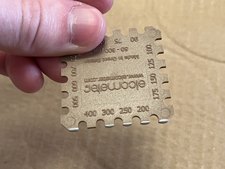The Importance Of Wet Film Thickness
Wet film thickness, also known as WFT, is the measurement of the thickness of a coating as it is being applied.
All coatings get their strength and other characteristics from their wet film weight. Consequently if the product is applied too thinly, it may not be able to gain it’s full adherence to the substrate and of course, it will be far more susceptible to mechanical damage.
Liquasil’s BBA Approved metal roof coating, Metalseal for example, is recommended to be applied at a wet film weight of c300 microns. When cured, the dry film weight (DFT) will be around the 250-260 microns mark.
The reason for the difference between the WFT and the DFT is due to evaporation of the small amount of solvent that is present in the Metalseal product.
Coatings that do not contain solvent (solvent-free) contain 100% volume solids, meaning that there is no evaporation of ingredients. This means that on a solvent free product, such as Liquasil’s Flexlap cut edge corrosion treatment top coat, if the wet film thickness is 500 microns, the dry film thickness will also be 500 microns.
All coating and paint manufacturers provide details of their products’ recommended wet and dry film thicknesses on documents called Technical Data Sheets, also referred to as TDS.
Another way of ensuring coating products are installed correctly, is to refer to the manufacturer’s TDS to determine the coverage rate for their products. Metalseal for example has an approximate coverage rate of 3 sq metres per litre. As the product is supplied in 20 litre drums, the installer can expect around 60 sq metres total coverage from the can.
Therefore, marking out a 60 sq metre area on the roof, accounting for corrugations and using all of the contents of the tin in that area, should result in roughly the same film weight throughout.
Measuring Wet Film Thickness
During application of the roof coating, the installer should be taking regular measurements of the film thickness using a “wet film comb” also known as a “wet film gauge.”
There are various types and shapes available, but they all perform in the same way. Metal ones tend to be more accurate, as they are made using precision engineering, but on site, most people use disposable plastic wet film combs.
A wet film comb resembles a small, handheld ruler. However, instead of traditional linear markings, it features a series of precisely spaced notched teeth. Each tooth represents a specific thickness measurement, typically in micrometres or mils (thousandths of an inch).
The edge of the comb is placed vertically onto the freshly applied wet coating. As the comb penetrates the film, the teeth will sink until they meet resistance from the substrate below. The depth at which the teeth stop corresponds to the thickness of the wet film, as demonstrated in the images.
The most commonly used WFT gauges used in the UK are from Elcometer.


